Cleaning with Oxygen Bleach
by: Dale Cox
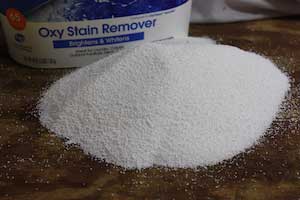
Oxygen bleach has been around for a long time but has only just recently found popularity as a cleaning agent around the house. Ask most people how to whiten fabrics or clean stains and they will tell you to use chlorine bleach. This has long been the go-to solution for getting some surfaces and fabrics truly clean.
The problem with traditional laundry bleach is its toxic effects on humans, animals and the environment. Bleach fumes damage your lungs and organs and direct contact will harm skin, eyes, and other soft tissue. In the environment, chlorine bleach persist and accumulates over time causing long-term harm to plants and wildlife, especially fish and birds. This toxic nature makes bleach very undesirable for cleaning surfaces around the house that need a good brightener or cleaner. Oxygen bleach by contrast is totally safe for plants, animals, and the environment. This is because the chemical base for oxygen bleach is sodium carbonate, also called soda ash, which at its worst is slightly alkaline.
What is Oxygen Bleach?
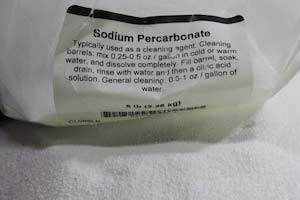
To make oxygen bleach cleaners, hydrogen peroxide is added to soda ash to produce a granular powder known as sodium percarbonate. When you add a bit of this sodium percarbonate, or SP, powder to water, it reacts by releasing the trapped oxygen from the peroxide.
This bubbling action lifts organic dirt and stains from surfaces it comes in contact with. And because it doesn't harm the surroundings like chlorine bleach, you can use it anywhere including exterior surfaces like house siding, decks, fences, and masonry to remove annoying mildew and algae stains as well as accumulated dirt and grime.
Oxygen Bleach in the Marketplace
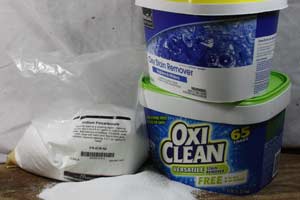
Not all oxygen bleaches are created equal, the concentration of SP varies dramatically from one to another with ultra-concentrated products containing up to 100% sodium percarbonate and laundry products like OxiClean® containing 50-60%. Household cleaner labeled "containing oxygen bleach" like dishwasher detergents and toilet bowl cleaners typically contain around 25% SP. Usually the cheaper the oxygen bleach product, the less SP it contains and the less effective it is as a cleaner.
While price is a good indicator of the amount of sodium percarbonate present in a product and the resulting effectiveness of the cleaner, 100% pure sodium percarbonate sold by the pound is about the same price as laundry cleaners containing only about 50% SP. You won't find 100% sodium percarbonate at your local home store but you can buy it online and in large quantities for about $2 a pound.
Mixing and Applying Oxygen Bleach
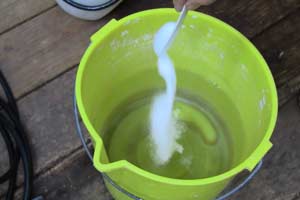
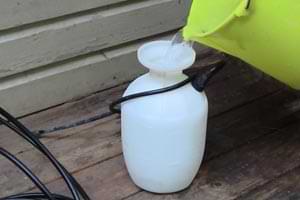
To activate its cleaning power, you have to dissolve sodium precarbonate in water. Typically warm water is used to dissolve the powder and release the oxygen. This takes about 10 minutes and the chemical reaction activity continues for about an hour.
If you're using pure sodium precarbonate to clean a deck or other tough job, use about 2 tablespoons to a gallon of warm or hot water. If you're using OxiClean® or a similar product, the label usually calls for about 1 cup to a gallon of water. Stir the powder around a bit and let it stand until it dissolves completely.
When it's ready, you can apply the active solution by pouring it onto surfaces like deck floors and then spreading it around with a broom but using a sprayer makes it easier to evenly saturate a surface and keep it wet, a critical part of getting the full benefit of the cleaning action. A garden compression sprayer works well for this and makes it possible to cover vertical surfaces like deck railings, fences, and house siding in addition to floors and other horizontal surfaces.
Cleaning Exterior Surfaces
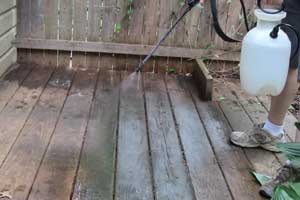
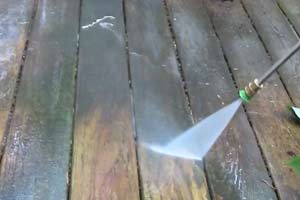
After you saturate a surface with activated oxygen bleach, keep it wet. If necessary spray repeatedly to ensure a consistently wet surface. Because of the need to keep everything wet until you're ready to rinse, it's best to clean outside surfaces when the weather is overcast or the area is shaded in some other way to prevent the sun from drying things out too quickly. Let the bleach solution sit on the surface for 10 minutes or more and then scrub or otherwise dislodge the dirt, algae and other surface film.
Scrubbing with a brush can be very labor intensive and most people will try to avoid this part of the job. However, it's absolutely necessary to physically remove the dirt in some way so it can be rinsed away. A pressure washer can be an excellent solution to this problem. The force of the water can effectively carry the dirt, etc. lifted by the oxygen bubbles from a surface with minimal effort on your part.
While pressure washers are great for cleaning exterior surfaces around the house and shop, they can be destructive if care isn't used when choosing the machine and spray tip. For instance, a gas powered pressure washers will pummel a surface with 3000 psi or more of water pressure. This kind of force can peel paint, gouge wood, and even cut skin and muscle tissue if you're unfortunate enough to get in the way of the spray. For this reason it's best to use an electric power washer, which typically has a relatively low 1800 psi average water pressure, to clean decks or siding to avoid damage to the wood, etc. For more on power washers, their features and uses, check here.
With the dirt film scrubbed or otherwise loosened, rinse with plenty of clean water before things have a chance to dry and stick to the surface again. If you're using a pressure washer, this will be done in one step. After rinsing, all you have to do is wait for things to dry out and if appropriate, apply protective coatings like wood sealers for decks and fences or paint on house siding.